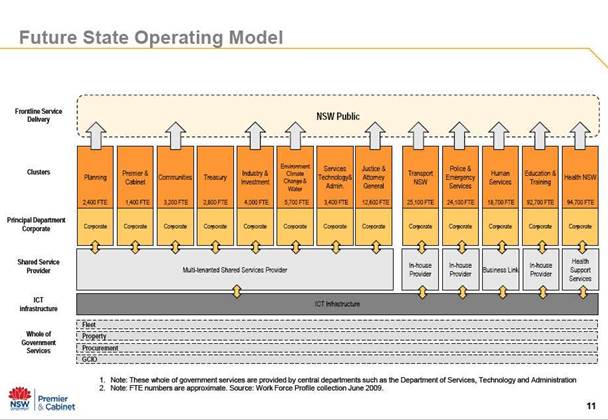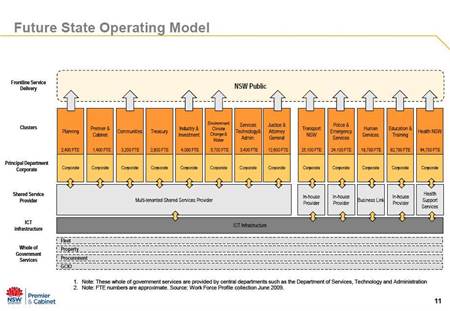The New South Wales Government has revealed a blueprint for how it plans to restructure its ICT and other shared service operations over the next two years.

The 181-page blueprint, produced by the NSW Department of Premier and Cabinet, expands on existing efforts to reform service delivery within the government, such as the consolidation of departments into 13 'super agencies', which took effect in July last year.
The NSW Government plans a future model involving five in-house shared service provider organisations for each of its largest agencies - Transport, Police and Emergency Services, Human Services, Education and Training, and NSW Health - plus one multi-tenant shared service provider (Service First) to serve the remainder.
Service First already provides shared services to more than 80 smaller NSW agencies, but under the blueprint would also pick up work from the NSW Treasury and the Department of Premier and Cabinet.
But all of these shared services organisations, the blueprint said, will be "supported by a single ICT wholesale operator".
No mention is made of an upcoming tender for a single ICT wholesale operator, but the schedule released within the blueprint appears to overlap with the end of the current IT panel arrangements.

The NSW Department of Premier and Cabinet was unable to comment before deadline. Consultant and blueprint co-author Steve Metzmacher, director of Third Horizon Group, refused to comment.
A spokesman for fellow co-author The Hackett group said the company helped the NSW Government "identify opportunities for improvements" in service delivery, but doubted it would result in a single, whole-of-government ICT services contract.
"There is no single outsourced provider that could provide everything the NSW Government needs," he said. "I don't think this is a massive win for anybody."
IT implications
Under the blueprint, corporate services units internal to each government agency remain responsible for strategic decision making and investments, but the bulk of the slog work is provided by shared services organisations.
When it comes to ICT, the CIO of each agency would retain responsibility for ICT strategy, 'investment prioritisation', standards and risk management.
But everything from enterprise architecture planning, project management and delivery, technology research and advice down to application development and maintenance, infrastructure support and disaster recovery would be provided via shared services organisations.
The blueprint held up Queensland's shared services initiatives as a potential model.
In the area of payroll, for example, the NSW plan would see internal corporate units retain responsibility for "personnel data security and policy", but shared services organisations would be asked to manage payroll processing, data reporting and compliance.
In Queensland, shared services efforts around payroll systems led to 35,000 payroll anomalies, a damning audit and eventually a promise from Premier Anna Bligh to scrap the shared services model.
But the New South Wales blueprint - completed before the problems in Queensland came to light - recommends shared services be applied across all agencies except Government-owned corporations.
The plan suggests that spend on ICT infrastructure would be reduced under a shared services arrangement, "enabling improved [technology] refresh rates and better quality."
But equally, the move to shared services was expected to require "significant investment in upgrading and standardisation of systems... to underpin new Corporate and Shared Services environments," the blueprint said.
The authors expected "significant economies of scale will be achieved from standardising the technology applications, platforms and data centres."
They recommended the NSW Government consider driving down cost by engaging with "larger, possibly outsourced data centres" and adopting server-level virtualisation.
Elevating ICT importance
The document also delved into potential reporting lines under the restructure.
Typically, ICT units within a given NSW Government agency would sit within Corporate Services - and the head of Corporate Services would then report to the Director General of the agency.
But the blueprint notes that should ICT be "of particular importance" to a department, the head of ICT will either report directly to the Director General or even be given an "elevated function in a shared role as the head of corporate services."
The CIO of each agency will be asked to "work with the technology team" at shared services units and the wholesale IT provider to "ensure all legacy activities are considered" during the transition period.



.png&h=140&w=231&c=1&s=0)


 iTnews Executive Retreat - Security Leaders Edition
iTnews Executive Retreat - Security Leaders Edition












_(1).jpg&h=140&w=231&c=1&s=0)



